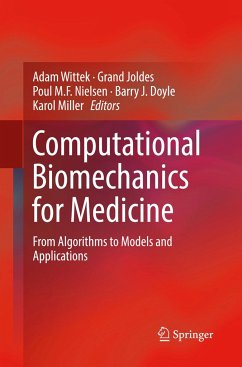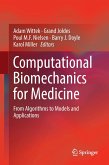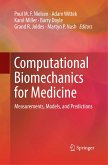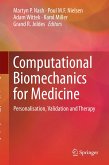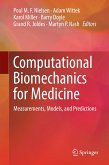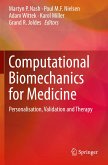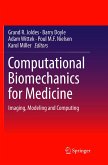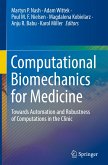Computational Biomechanics for Medicine
From Algorithms to Models and Applications
Herausgegeben:Wittek, Adam; Joldes, Grand; Nielsen, Poul M.F.; Doyle, Barry J.; Miller, Karol
Computational Biomechanics for Medicine
From Algorithms to Models and Applications
Herausgegeben:Wittek, Adam; Joldes, Grand; Nielsen, Poul M.F.; Doyle, Barry J.; Miller, Karol
- Broschiertes Buch
- Merkliste
- Auf die Merkliste
- Bewerten Bewerten
- Teilen
- Produkt teilen
- Produkterinnerung
- Produkterinnerung
This volume comprises the latest developments in both fundamental science and patient-specific applications, discussing topics such as: cellular mechanics; injury biomechanics; biomechanics of heart and vascular system; medical image analysis; and both patient-specific fluid dynamics and solid mechanics simulations. With contributions from researchers world-wide, the Computational Biomechanics for Medicine series of titles provides an opportunity for specialists in computational biomechanics to present their latest methodologies and advancements.
Andere Kunden interessierten sich auch für
![Computational Biomechanics for Medicine Computational Biomechanics for Medicine]() Computational Biomechanics for Medicine154,99 €
Computational Biomechanics for Medicine154,99 €![Computational Biomechanics for Medicine Computational Biomechanics for Medicine]() Computational Biomechanics for Medicine116,99 €
Computational Biomechanics for Medicine116,99 €![Computational Biomechanics for Medicine Computational Biomechanics for Medicine]() Computational Biomechanics for Medicine116,99 €
Computational Biomechanics for Medicine116,99 €![Computational Biomechanics for Medicine Computational Biomechanics for Medicine]() Computational Biomechanics for Medicine116,99 €
Computational Biomechanics for Medicine116,99 €![Computational Biomechanics for Medicine Computational Biomechanics for Medicine]() Computational Biomechanics for Medicine116,99 €
Computational Biomechanics for Medicine116,99 €![Computational Biomechanics for Medicine Computational Biomechanics for Medicine]() Computational Biomechanics for Medicine116,99 €
Computational Biomechanics for Medicine116,99 €![Computational Biomechanics for Medicine Computational Biomechanics for Medicine]() Computational Biomechanics for Medicine131,99 €
Computational Biomechanics for Medicine131,99 €-
-
-
This volume comprises the latest developments in both fundamental science and patient-specific applications, discussing topics such as: cellular mechanics; injury biomechanics; biomechanics of heart and vascular system; medical image analysis; and both patient-specific fluid dynamics and solid mechanics simulations. With contributions from researchers world-wide, the Computational Biomechanics for Medicine series of titles provides an opportunity for specialists in computational biomechanics to present their latest methodologies and advancements.
Produktdetails
- Produktdetails
- Verlag: Springer / Springer International Publishing / Springer, Berlin
- Artikelnr. des Verlages: 978-3-319-85403-8
- Softcover reprint of the original 1st ed. 2017
- Seitenzahl: 184
- Erscheinungstermin: 9. Mai 2018
- Englisch
- Abmessung: 235mm x 155mm x 11mm
- Gewicht: 292g
- ISBN-13: 9783319854038
- ISBN-10: 3319854038
- Artikelnr.: 53570411
- Herstellerkennzeichnung Die Herstellerinformationen sind derzeit nicht verfügbar.
- Verlag: Springer / Springer International Publishing / Springer, Berlin
- Artikelnr. des Verlages: 978-3-319-85403-8
- Softcover reprint of the original 1st ed. 2017
- Seitenzahl: 184
- Erscheinungstermin: 9. Mai 2018
- Englisch
- Abmessung: 235mm x 155mm x 11mm
- Gewicht: 292g
- ISBN-13: 9783319854038
- ISBN-10: 3319854038
- Artikelnr.: 53570411
- Herstellerkennzeichnung Die Herstellerinformationen sind derzeit nicht verfügbar.
Adam Wittek: Adam Wittek is a Professor in the School of Mechanical and Chemical Engineering at the University of Western Australia and Deputy Director of Intelligent Systems of Medicine Laboratory within the School of Mechanical and Chemical Engineering. His research is primarily in computational biomechanics for medicine and injury analysis and prevention. Grand Joldes: Grand Joldes is a senior researcher at the University of Western Australia. His research area is the development and application of numerical methods in computational biomechanics. Poul M. F. Nielsen: Poul's research focuses on using novel instrumentation, detailed computational models, and quantitative descriptions of physical processes to gain a better understanding of human physiology. Many of his projects couple mathematical modelling with innovative instrumentation to improve our ability to understand and interpret measurements of complex biological systems, subject to the constraints of well-understood physical conservation and balance laws. Barry Doyle: Barry Doyle is a Senior Lecturer and NHMRC RD Wright Biomedical Fellow in the School of Mechanical and Chemical Engineering at the University of Western Australia and also Head of Vascular Engineering at the Harry Perkins Institute of Medical Research. His research is primarily in cardiovascular biomechanics. Karol Miller: Karol Miller is a Winthrop Professor of Applied Mechanics and Director of Intelligent Systems for Medicine Laboratory at the University of Western Australia, Honorary Distinguished Professor at Cardiff University and a Laureate of Humboldt Research Award at University of Bremen. His research interests include biomechanics, numerical methods and robotics. His current primary research focus is computational biomechanics for medicine.
Chapter1. The Effects of Geometric Variation from OCT-Derived 3D Reconstructions on Wall Shear Stress in a Patient-Specific Coronary Artery.- Chapter2. Constitutive Modelling of Lamb Aorta.- Chapter 3. Quantifying Cytoskeletal Morphology in Endothelial Cells to Enable Mechanical Analysis.- Chapter 4. Computational Approaches for the Modelling of Atherosclerotic Plaque Progression.- Chapter5. Reduced Order Model of a Human Left and Right Ventricle Based on POD Method.- Chapter6. Estimation of the Permeability Tensor of the Microvasculature of the Liver through Fabric Tensors.- Chapter7. Motion Estimation with Finite-Element Biomechanical Models and Tracking Constraints from Tagged MRI.- Chapter8. Subpixel Measurement of Living Skin Deformation Using Intrinsic Features.- Chapter9. Three-Dimensional Glenohumeral Joint Kinematic Analyses From Asynchronous Biplane Fluoroscopy Using an Interpolation Technique.- Chapter10. An Evaluation of Adaptive Biomechanical Non-Rigid Registration forBrain Glioma Resection using Image-Guided Neurosurgery.- Chapter11. Registration of Prone and Supine Breast MRI for Breast Cancer Treatment Planning.- Chapter12. Evaluation of Strains on Levator Ani Muscle: Damage Induced During Delivery for a Prediction of Patient Risks.- Chapter.13. Abusive Head Trauma - Developing a computational Adult Head Model to Predict Brain Deformations Under Mild Accelerations.- Chapter14. Computation of Brain Deformations Due to Violent Impact: Quantitative Analysis of the Importance of the Choice of Boundary Conditions and Brain Tissue Constitutive Model.
Chapter1. The Effects of Geometric Variation from OCT-Derived 3D Reconstructions on Wall Shear Stress in a Patient-Specific Coronary Artery.- Chapter2. Constitutive Modelling of Lamb Aorta.- Chapter 3. Quantifying Cytoskeletal Morphology in Endothelial Cells to Enable Mechanical Analysis.- Chapter 4. Computational Approaches for the Modelling of Atherosclerotic Plaque Progression.- Chapter5. Reduced Order Model of a Human Left and Right Ventricle Based on POD Method.- Chapter6. Estimation of the Permeability Tensor of the Microvasculature of the Liver through Fabric Tensors.- Chapter7. Motion Estimation with Finite-Element Biomechanical Models and Tracking Constraints from Tagged MRI.- Chapter8. Subpixel Measurement of Living Skin Deformation Using Intrinsic Features.- Chapter9. Three-Dimensional Glenohumeral Joint Kinematic Analyses From Asynchronous Biplane Fluoroscopy Using an Interpolation Technique.- Chapter10. An Evaluation of Adaptive Biomechanical Non-Rigid Registration forBrain Glioma Resection using Image-Guided Neurosurgery.- Chapter11. Registration of Prone and Supine Breast MRI for Breast Cancer Treatment Planning.- Chapter12. Evaluation of Strains on Levator Ani Muscle: Damage Induced During Delivery for a Prediction of Patient Risks.- Chapter.13. Abusive Head Trauma - Developing a computational Adult Head Model to Predict Brain Deformations Under Mild Accelerations.- Chapter14. Computation of Brain Deformations Due to Violent Impact: Quantitative Analysis of the Importance of the Choice of Boundary Conditions and Brain Tissue Constitutive Model.

